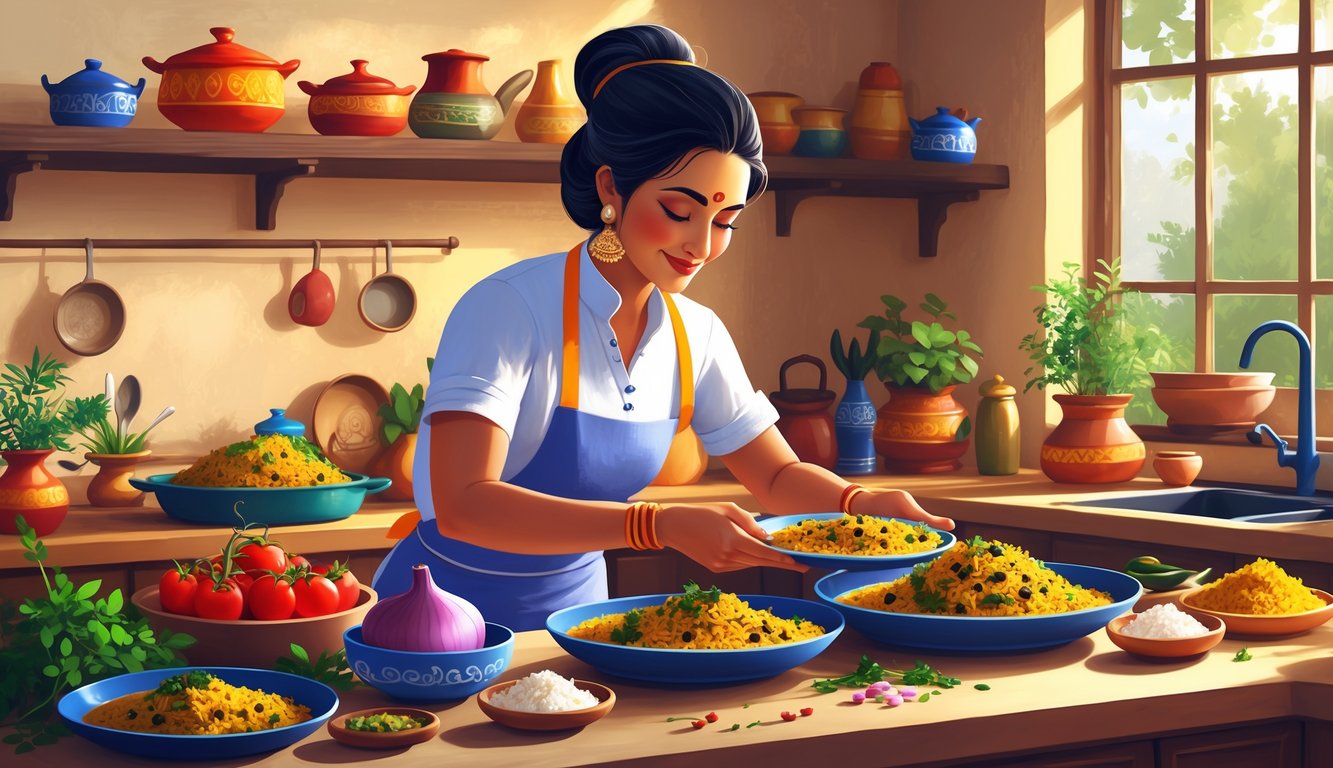
Okay, so here’s what keeps bugging me about Indian home recipes: people keep repeating that they’re better than restaurant versions, and, you know, I actually buy it—but the reasons are so basic, it almost feels like a prank. Why does takeout never get that sharp, tangy thing right in South Indian chana masala? My neighbor Geetha, who hoards garam masala in a bag that looks like it survived a flood, says it’s all about soaking chickpeas in tamarind overnight. Is that it? Really?
The honest bit: Indian home recipes, the ones actual experts vouch for, don’t cut corners. They drown everything in onions so slowly you start questioning your life choices, and—somehow—the food ends up tasting richer, less fake, and, I don’t know, just more real than anything you get at a restaurant.
Julian Voigt and the r/AskCulinary crowd argue about this constantly, but every home cook I trust (plus every WhatsApp auntie who’s ever spammed me) just says: forget the recipe, fixate on onions, don’t cheat on garlic, and if you use packet spices, you’re basically doomed.
Restaurants? They’re obsessed with speed. They batch gravies days in advance, barely toast spices, and wouldn’t let the kitchen smell like cardamom for more than 10 minutes if their lives depended on it. Maybe that’s why my so-called “better-than-takeout” chicken tikka masala gets everyone in the apartment running to the stove instead of ordering in—at least, that’s what the restaurant secrets and “healthy” pro recipes claim. But nobody mentions the graveyard of empty spice jars or the absolute chaos of making garlic naan from scratch. Am I missing some secret cleaning hack? Maybe if I ran my kitchen like a restaurant, I’d be less of a disaster and still win the taste-off. Or maybe wild, homemade food just isn’t meant to be tamed. Unless I buy a commercial vent hood. Not happening.
Why Indian Home Recipes Outsmart Restaurant Versions
Here’s what I don’t get: why do people act like restaurant Indian food is the peak? It’s not. At home, every shortcut feels like a crime, every ingredient swap sparks a family feud, and that slow-burn obsession always beats the buttery, oversalted restaurant stuff. Every. Single. Time.
Authenticity of Flavors
Ever tried getting that weird hing and kasuri methi balance at a Curry House? Good luck. My aunt’s got a cumin jar from 2016, claims it’s “aged,” and I honestly think she’s right. Chefs brag about “secret blends,” but home cooks? They just repeat whatever their parents did, sometimes with more stubbornness than sense. Reddit’s full of people complaining that restaurant food misses the mark on unique seasonings, and, yeah, they’re not wrong.
It gets even more absurd. Restaurants use premade curry bases, which just bulldoze half the subtle, smoky, slightly bitter magic you get from doing tadka at home, probably at some ungodly hour. “Nobody eats restaurant dal at Diwali,” my cousin says, and he’s not joking—home technique is passed down, and the result isn’t copy-paste-able.
Some recipes taste off anywhere else—like, if your pressure cooker isn’t dented and ancient, is it even real dal? Every bite drags up memories no restaurant can fake, and it’s always just right—unless you’re distracted and dump in double the ghee. Not that I’d ever do that. (I would.)
Ingredients Quality at Home
I can’t do “ready to eat” packets (and packet masalas? Hard pass). I want to see every ingredient lined up, judge every tomato for being too orange, and yes, sometimes use coriander that’s more stem than leaf. There’s nostalgia in weird amchur slices and balcony-grown cilantro. Chefs talk about “farm-to-table,” but at home, I’m texting neighbors for curry leaves because the store ones are already dead.
People obsess over “single origin” this and that, but my mom’s friend sniffs every cardamom pod before buying. Even the best spice brands are inconsistent. If I’m making rajma, those beans soak overnight—never from a can. Restaurant cooks chase efficiency, but I’m over here panicking about whether my onions are brown enough.
Batch-cooking at restaurants means everything’s just… averaged out. At home, mistakes are part of the process. One burnt paratha and you’ll hear about it for years. Tomatoes for butter chicken? Peel them by hand or don’t bother. Every gram, every ingredient, gets the full drama treatment, and it does make a difference.
Healthier Cooking Techniques
Don’t get me started on how much butter and cream restaurants dump into dal makhani. I’m over here reading nutrition labels, using yogurt instead of cream, and sometimes air-frying samosas (my mom thinks I’m a heretic, but my arteries disagree). Those glossy ghee puddles on restaurant dishes? I skip them, and, honestly, the food tastes brighter.
Indian Express called out the sugar, fat, and salt overload in pro kitchens. Not exaggerating. At home, I taste every five minutes, adjust with a pinch of this or that, and never end up with that restaurant-style sugar bomb that leaves you chugging water.
Biryani at home doesn’t sit like a brick in your stomach. It’s lighter, easier to eat, and, sure, sometimes I miss the creamy finish, but at least my olive oil lasts longer than a week. All those little swaps—less fat, more flavor—add up. My recipes age better, and, honestly, so do I.
Essential Spices and Ingredients Used By Indian Home Cooks
It’s ridiculous—one day I’m using some sad store-bought spice kit, the next I’m obsessed with ground coriander and fresh cilantro, because, apparently, Indian home kitchens never run out of either. Every home cook I know says restaurant food just drowns everything in oil or cream and misses the real punch you get from actual spices.
Must-Have Spice Blends
First time I saw a legit home pantry? I just stared. Tins labeled garam masala—not store-bought, but roasted and ground at home: cumin, cardamom, black pepper, cloves, whatever else. No “one-size-fits-all” blend. Every family tweaks it—some go heavy on cinnamon, some ban it. Recipe blogs and cookbooks love to quote their mothers: “store-bought garam masala is flat.”
Turmeric? Not that neon powder. Home cooks use the good stuff for flavor, color, and to brag about “health benefits.” Coriander seeds, sometimes whole, sometimes ground. Cumin feels less intimidating when you buy seeds and toast them. Experts always say to skip supermarket mixes for fresh grinds—see here—because the smell alone changes everything, even if you’re just making dal.
Fresh Herbs and Aromatics
My friend once handed me half-dead cilantro and claimed it’d “save” my curry. She wasn’t wrong. Cilantro’s everywhere—stems, roots, whatever. Chop and dump, flavor’s fixed. Every kitchen has a pot of it.
Ginger and garlic? Always fresh, grated, never dried. Onions go into every base. Older cooks organize spices by how you start: mustard seeds sizzle, then onions, then everything else. Chiles—red, green, raw, fried—no logic, just whatever’s around. Curry leaves, if you get them, go in last, because “otherwise the dish is sad.” I don’t make the rules.
Dairy and Plant-Based Staples
Yogurt isn’t just for lassi. It’s everywhere—marinades, sauces, whatever. Full-fat, homemade, or nothing. Ghee? Forget margarine. That nutty flavor wins every time.
Paneer’s supposedly easy: boil milk, lemon juice, cheesecloth, done. Lentils and beans—rajma, chana—are the backbone. People swap in coconut or cashew pastes for vegan stuff. Tamarind pulp? Found it in a lunchbox once, don’t ask. Butter and cream show up when you want that dhaba vibe, but at home, people usually hold back.
Whole Versus Ground Spices
I used to buy everything pre-ground. Big mistake. Home kitchens always have a dry grinder. Toasted whole spices—like cumin—smell so good, you know it’s Indian food immediately.
Sometimes you grind on the spot, sometimes in batches. Shelves are stacked: cardamom pods, jars of ground cumin, turmeric, cinnamon sticks for biryani. Try explaining why you need both whole and ground—nobody really can. It’s just about texture and timing. Whole for slow flavor, powder for punch. Best tip? Buy fresh, store airtight, avoid sad “masala packets.” Even Kitchn’s spice list says: start simple, trust your nose, and toss old spices every six months. I never do, but hey.



